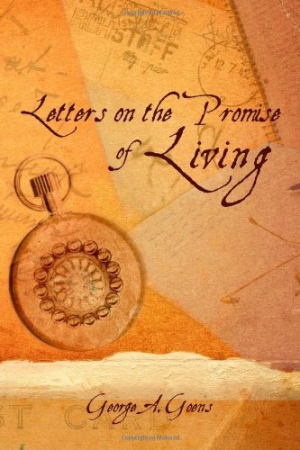Letters on the Promise of Living
All children should be so lucky as to have grandfathers who write letters to them of the quality found in George Goens’ Letters On The Promise Of Living. Fortunately, many young people may benefit from his book’s wisdom, because it is intended for grandparents who want to help their grandchildren learn about life’s deeper purposes.
Inspiration for this book of letters came to the author after he reread one that his recently deceased daughter wrote to him from college. Her letter reminded him that a handwritten correspondence tells much more about the person who pens it than an e-mail or text message could ever do. He originally wrote the letters to his grandchildren, in long hand, while sitting in the serene atmosphere of an old New England church and recalling the common-sense wisdom of his mother, the loss of his father at an early age, good and bad decisions that determined his life’s path, and ideas gleaned from notable people. Topics covered in the letters, which are separated into correspondingly titled chapters in the book, include happiness, sadness, relationships, truth, and courage.
Goens’ career as an educator, leadership consultant, and writer informs his life experience, but the tone of his letters is personal. He focuses on devotion to family and concern for his grandchildren’s future, especially the two who have been left motherless.
A quote from Abraham Lincoln’s second inaugural address highlights his letter about forgiveness: “With malice toward none, with charity for all….” The president’s speech urged people of the North and South to reconcile after the Civil War ended. Goens notes that forgiveness prevents humans from retaliating with similar unkind action toward those who have inflicted harm on them. He then explains that, “forgiveness offers us the gift of healing.”
Beauty inspires people in diverse ways, but Goens tells his grandchildren that the most profound beauty can be found in a person’s “inner core,” arguing that those who dwell only on the physical appeal of youthful faces and bodies fail to realize this. “All people have an innate beauty to them with their gifts, passions, character, and talents,” he writes.
The most effective letter in this collection concerns justice. Acknowledging that justice seems like a difficult subject for young people to understand, Goens says they must be prepared to deal with issues of justice that will occur throughout their lives. The chapter concludes with his commentary on justice and peace, originally published in the New York Times, the essay explains the circumstances of his daughter’s death*.*
The author worries that his grandchildren might find the tone of his letters too preachy. However, his thoughtful advice, written with subtle humor, sounds neither pedantic nor self-satisfied. The narrative’s relaxed, conversational style succeeds admirably in conveying his character and empathy.
Goens deserves commendation for sharing these letters with a wider audience. People of all ages will benefit from reading the book, but especially those charged with conveying to young people the possibilities for leading meaningful lives.
Reviewed by
Margaret Cullison
Disclosure: This article is not an endorsement, but a review. The publisher of this book provided free copies of the book and paid a small fee to have their book reviewed by a professional reviewer. Foreword Reviews and Clarion Reviews make no guarantee that the publisher will receive a positive review. Foreword Magazine, Inc. is disclosing this in accordance with the Federal Trade Commission’s 16 CFR, Part 255.

